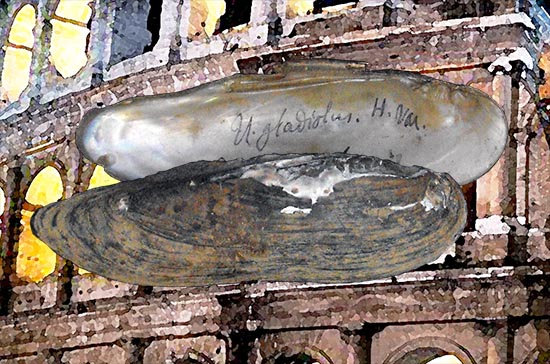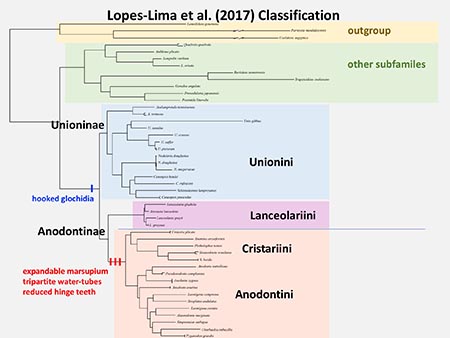| Page last updated
7 September 2017 |
Mussel of the Month
The September 2017 Mussel of the Month is Lanceolaria gladiola. Lanceolaria is a genus of 10 species found in eastern Asia, from Vietnam north to Japan.

MNHN. Ngan-hue (=Anhui), China (type).
|
Back in November 2012, Lanceolaria grayana was the Mussel of the Month, and we used it as an opportunity to discuss the subfamily classification of the freshwater mussel family Unionidae (at least as we understood it then). Among those subfamilies is the Unioninae, which includes mussels like Unio, Lanceolaria, and Anodonta. As we pointed out back then, the subfamily is distinctive because it is easily recognized by morphological characteristics. The combination of hooked-type glochidia (parasitic larvae) and ectobranchy (brooding in the outer demibranchs) is diagnostic of the Unioninae. The other subfamilies haven't really beeen characterized except as clades in molecular analyses.
Back in 2006, we were unable to classify most of the Old World freshwater mussel genera to the rank of subfamily because we didn’t have molecular data for them (Graf & Cummings, 2006). Bouchet & Rocroi (2010) proposed a novel subfamily classification based on input from the community but only scant additional phylogenetic data. For the most part, it turns out their classification has been largely accurate in the sense that it has been reflected in recent phylogenetic studies — with a few modifications here and there (Whelan et al., 2011; Pfeiffer & Graf, 2015; Lopes-Lima et al., 2017). However, it is still the case, based on the recent genus-rich sampling of Lopes-Lima et al. (2017), that if we don’t have the molecules, the mussels can’t be classified. Any genus not included in their analysis was regarded as incertae sedis — even the North American Pegias.*
Interestingly, Lopes-Lima et al. (2017) proposed a revision to the classification of the Unioninae. Since Y2K, the subfamily has been divided among two tribes, Unionini and Anodontini. The anodontines** are easily recognized by the modifications of their marsupium to accommodate lateral expansion (i.e., gravid gills look like inflated mattresses) and the presence of tripartite water tubes. The unionine genera lack these characteristics.
 Lopes-Lima et al. (2017) discovered that “unionines” like Lanceolaria and Arconaia share a more recent common ancestor with Anodonta than Unio. That is, the Unionini as we have traditionally viewed it, is paraphyletic. These authors proposed splitting the Unioninae into two subfamilies: Unioninae and Anodontinae (including the new tribe, Lanceolariini). That is a reasonable proposal that names every clade that needs a name. However, the problem with this scheme is that it separates the named taxa from their non-molecular synapomorphies (i.e., diagnostic derived characters). The unionid clade diagnosed by hooked-type glochidia would no longer have a name — mussels with that character could belong to either the Unioninae or the Anodontinae. Even the distinctive characteristics of the anodontines no longer refer to a named taxon. The subfamily Anodontinae includes genera like Lanceolaria that lack tripartite water tubes and marsupia capable of expansion, and the mussels that do have those characters are split between two tribes, Anodontini and Cristariini. Lopes-Lima et al. (2017) discovered that “unionines” like Lanceolaria and Arconaia share a more recent common ancestor with Anodonta than Unio. That is, the Unionini as we have traditionally viewed it, is paraphyletic. These authors proposed splitting the Unioninae into two subfamilies: Unioninae and Anodontinae (including the new tribe, Lanceolariini). That is a reasonable proposal that names every clade that needs a name. However, the problem with this scheme is that it separates the named taxa from their non-molecular synapomorphies (i.e., diagnostic derived characters). The unionid clade diagnosed by hooked-type glochidia would no longer have a name — mussels with that character could belong to either the Unioninae or the Anodontinae. Even the distinctive characteristics of the anodontines no longer refer to a named taxon. The subfamily Anodontinae includes genera like Lanceolaria that lack tripartite water tubes and marsupia capable of expansion, and the mussels that do have those characters are split between two tribes, Anodontini and Cristariini.
-----
* Pegias is unquestionably a member of the tribe Anodontini. Even more specifically, it belongs to the eastern Nearctic clade we like to call subtribe Alasmidontina. At least, based on its anatomy and geography (Ortmann, 1914; Williams et al., 2008).
** Like Pegias.* |
|
Classification:
Phylum Mollusca
Class Bivalvia
Subclass Palaeoheterodonta
Order Unionoida
Family UNIONINDAE Rafinesque, 1820
Subfamily UNIONINAE s.s.
Tribe LANCEOLARIINI Froufe, Lopes-Lima & Bogan, 2017
Genus Lanceolaria Conrad, 1853
Species Lanceolaria gladiola (Heude, 1877) |
To find out more about Lanceolaria and the classification of the Unioninae, check out:
- Bouchet, P. & J.-P. Rocroi. 2010. Nomenclator of bivalve families; with a classification of bivalve families by R. Bieler, J.G. Carter & E.V. Coan. Malacologia 52(2): 1-184.
- Graf, D.L. & K.S. Cummings. 2006. Palaeoheterodont diversity (Mollusca: Trigonioida + Unionoida): what we know and what we wish we knew about freshwater mussel evolution. Zoological Journal of the Linnean Society 148: 343-394.
- Lopes-Lima, M., E. Froufe, V.T. Do, M. Ghamizi, K.E. Mock et al. 2017. Phylogeny of the most species-rich freshwater bivalve family (Bivalvia: Unionida: Unionidae): Defining modern subfamilies and tribes. Molecular Phylogenetics and Evolution 106: 174-191.
- Ortmann, A.E. 1914. Studies in najades (cont.). Nautilus 28(6):65-69.
- Pfeiffer, J.M. & D.L. Graf. 2015. Evolution of bilaterally asymmetrical larvae in freshwater mussels (Bivalvia: Unionoida: Unionidae). Zoological Journal of the Linnean Society 175(2): 307-318.
- Whelan, N.V., A.J. Geneva & D.L. Graf. 2011. Molecular phylogenetic analysis of tropical freshwater mussels (Mollusca: Bivalvia: Unionoida) resolves the position of Coelatura and supports a monophyletic Unionidae. Molecular Phylogenetics and Evolution 61: 504-514.
- Williams, J.D., A.E. Bogan & J.T. Garner. 2008. Freshwater Mussels of Alabama and the Mobile Basin in Georgia, Mississippi and Tennessee. University of Alabama Press, Tuscaloosa. 908 pp.
|